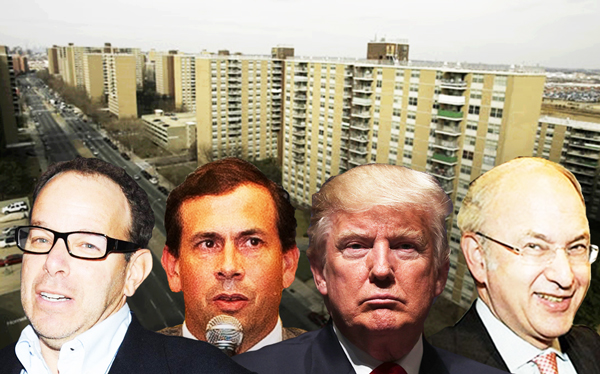Trending
From Bistricer to Rockpoint: The new Starrett City deal is a far cry from what might have been
“You couldn’t go at this like a piñata.”

Just 10 years ago, the largest federally subsidized housing development in the U.S. almost went market-rate.
At the height of the boom in 2007, with the owners planning to exit the Mitchell-Lama program, David Bistricer made a whopping $1.3 billion bid for Starrett City, the hulking 5,881-unit complex that straddles Canarsie and East New York. But the deal faced intense opposition from government officials and the community, and federal regulators ultimately blocked it.
“When they tried to sell it to us, the owners said they planned to take it out of the Mitchell-Lama program and officials were very upset,” Bistricer, who heads Clipper Equity, recalled. “At the time, the sellers weren’t considering affordability in order to achieve that price.”
Any similar play at Starrett City was seen as untenable, given the scrutiny that came with its status as a stronghold of affordability within an increasingly unaffordable city. That the 2006 Stuyvesant Town-Peter Cooper Village sale ultimately became a debacle didn’t help either. So when Rockpoint Group and Brooksville Company made a go at it this year, the only viable route was the affordable one. The price they agreed to pay for the complex reflects that – at $850 million, it is nearly 35 percent lower than Bistricer’s 2007 offer.
And while the Bistricer talks happened in an overheated market where the name of the game was leverage and aggressive destabilization, the climate in which this deal came together was starkly different, and so was the process by which the suitors were targeted.
“You couldn’t go at this like a piñata because then everyone would swing and you wouldn’t make it to first base,” said a source close to the property. “The result would have been a Bistricer sequel.”
“The man who designed it must have loved people.”
On Oct. 13, 1974, Mayor Abe Beame and Gov. Malcolm Wilson officially dedicated the complex, which was built to house 25,000 residents.
“A measure of the size is the fact that you can take the entire population of three Hudson River communities—Hastings, Dobbs Ferry and Irvington—and fit them all into Starrett City,” Beame said at the ceremony. He then presented oversize golden keys to five of the families who would live there.
“You know what I like about this place?” said Eileen Riccio, one of the early residents of the complex, according to the New York Times. “It’s a new concept in community living. The man who designed it must have loved people, because he didn’t leave anything out.”
Disque Deane, a pugnacious investor who at one time controlled the General Motors Building, led the development of the complex. His family continues to own it today, though it’s now officially known as Spring Creek Towers. Among Deane’s more than 100 limited partners in the ownership venture known as Starrett City Associates: President Trump, who according to the Times stands to personally net $14 million if the sale to Rockpoint and Brooksville goes through.
In 2007, Trump described the complex as “probably the greatest tax shelter ever made.” Last year alone, the project benefited from nearly $100 million in government subsidies – a $16 million federal tax cut and $80 million in rental subsidies.
But since 2009, the complex has been under an agreement with the state and federal government that guarantees its affordability until 2039. According to a spokesperson for Starrett City Associates, every apartment is designated affordable – including the 60 percent that fall under Section 8 and the remaining 40 percent that fall under either federal Section 236 or state Mitchell-Lama.
Bistricer, who owns at least 60 buildings in the city including the rent-stabilized Flatbush Gardens complex, said he is “not surprised” that the property ultimately sold for a “reduced price,” with the affordability agreement in place. The price per unit the deal is now expected to close at is $145,000, 34 percent lower than the $220,000 per unit Bistricer was offering.
An additional snag in the 2007 deal was Bistricer himself. Officials were concerned that the developer, who was criticized for allegedly refusing to accept Section 8 vouchers at Flatbush Gardens, would not be the best steward of tenants.
“What was really kind of scary was that a buyer that did not have a good reputation around how he treated residents, particularly low-income people,” was the front-runner, said Ismene Speliotis, a former director of Acorn who was part of a coalition that successfully lobbied HUD and HCR to deny Bistricer the opportunity to close on Starrett City and helped broker the 2009 affordability agreement.
Keep your buyers close
Though a deal of this magnitude is generally the talk of the town, its sensitive nature meant it came together under a shroud of secrecy uncommon in New York real estate.
Some of the most active multifamily brokers in Brooklyn and across the city did not even know it was being marketed for sale. Even some of the biggest owners of affordable housing in the city, such as L+M Development Partners, were unaware the property was in play. And according to sources, neither was the House Committee on Oversight and Government Reform, which launched an investigation into the complex in July.
About a year ago, a small group of the city’s largest residential landlords – including Blackstone Group, A&E Real Estate Holdings and the LeFrak Organization – toured the properties, but no serious negotiations arose, sources said. A plan to refinance the complex was also dropped. Blackstone and A&E declined to comment, and LeFrak could not be immediately reached.
Earlier this year, the owners brought on Cushman & Wakefield’s Doug Harmon to review their options. Harmon, who brokered the megadeal for Stuy Town in 2015, is said to have used a near-identical playbook for shopping Starrett City.
“The way large, complicated residential deals are successfully sold and marketed today is much more nuanced, complicated, bespoke and surgical in nature than when these types of deals were marketed a decade ago,” Harmon said. “With Starrett City, similarly to Stuy Town-Peter Cooper Village, our process was specifically designed to solve for many variables and stakeholders.”
Rather than circulate a prospectus, Harmon made a beeline for the most likely suitors. Only those with deep pockets need apply – players who would need to syndicate equity for the purchase were largely cut out.
Rockpoint is buying the property through its second core-plus fund, which targets long-term stable investments. The company, a Boston-based private equity firm led by Bill Walton and Keith Gelb, is said to be putting up the bulk of the equity. It has made over $4.6 billion in New York City acquisitions since 2010, according to Real Capital Analytics. Its partner on the deal, Brooksville, is led by Andrew MacArthur, a former executive at special servicer CWCapital Asset Management who led the sale of Stuy Town to Blackstone Group and Ivanhoe Cambridge. Brooksville, which launched last year, operates as an investment firm, as well as a property manager or “fee business” through an affiliate.
Trump’s small ownership interest may have added to the clandestine nature of the deal.
Through his revocable trust, the president is one of 100 limited partners with no managerial role in Starrett City. And as an individual limited partner in the syndication, he had no representation in the talks that led to the sales agreement, the spokesperson for Starrett City Associates said.
The individual partners do, however, have to approve any sale that comes together, according to a press release announcing the deal. A source familiar with the Trump Organization’s operations said that neither the president or his trust would be involved in decisions governing a passive, minority interest.
The buyers are now negotiating with Wells Fargo for acquisition financing and are targeting a loan of around $470 million, or 55 percent leverage, as The Real Deal reported last week. The sale, expected to close early next year, now heads to HCR and HUD for regulatory review.
Not your father’s Brooklyn
Starrett City’s current affordability agreement, in place until 2039, set guidelines for rents and puts income limits on new families seeking to move into the complex. When the agreement was struck in 2009, more than 3,500 of the 5,881 units were occupied by Section 8 tenants, locked into a 20-year agreement. Until 2025, the income limit is 80 percent of the current area mean income (AMI), which comes out to $76,320 for a family of four or $53,440 for an individual. But after 2025, that limit will move up, first to 125 percent of AMI and eventually to 140 percent.
One current limit on rent the ownership can charge is the so-called basic rental charge that is set in accordance with the National Housing Act. But there is a higher rent figure, called the Fair Market Rent (FMR), that can be used under certain circumstances and is set by HUD for each metropolitan area. A HUD spokesperson did not respond to a request for comment.
The affordability agreement stipulates that if the owners have prospective tenants making more than the current AMI limit, they can move to the building if they agree to pay a rent costing as much as that second rent figure, the FMR, allows. At Starrett City, the current FMR would be $1,419 for a one-bedroom apartment, following HUD’s most recent numbers for New York City.
This conceivably means that as tenants naturally vacate units over time, ownership could boost rental revenues by attracting higher-income tenants, who are now flocking over to traditionally lower-income Brooklyn neighborhoods.
“That’s a problem as a neighborhood changes and gentrifies, that’s scary,” said Speliotis, now executive director of the Mutual Housing Association of New York, an affordable housing developer and manager. “People don’t realize that the world changes, so they make these rules thinking that a neighborhood is always going to stay poor and there won’t be change.”
Starrett City also comes with nearly 6 million square feet of unused development rights, a treasure trove that Bistricer intended to avail of. The development rights consist of 4.85 million square feet reserved for community facility space; 150,000 square feet for residential space; and 700,000 square feet for commercial space, according to sources familiar with the zoning.
At the time of the 2009 refinancing, most of the unused air rights were transferred into a nonprofit entity controlled by the New York state Attorney General’s office, sources said.
The buyers-to-be have no plans to develop open spaces at the complex, according to a spokesperson for Brooksville, but are “not prepared to rule out some form of development in the future.” The spokesperson added, however, that any effort to use those rights would involve significant community input.
There are limits to the upside for the new owners, given that the HUD rules only allow the owners to take home 6 percent of the building’s profits in a given year. The Brooksville spokesperson said “our financial goals are long-term stable returns obtained through low leverage and cooperation with the community to achieve shared affordability goals.”
“They’re not looking for home runs,” said L+M CEO Ron Moelis. “People are looking for singles and doubles these days.”
But Speliotis said there are ways to make money through line items in the project’s operating budget that aren’t accounted for in that cap.
“You’ve got your accountants, you have your insurance, you have fuel, maintenance and repairs, supplies, you have management fees, you’ve got office expenses, bookkeeping expenses,” she said. “And if you the owner have any relationships to these line items, that money comes to you.”
(To view properties owned by Clipper Equity, click here)




